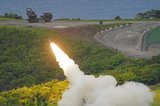Northrop Grumman, Bell Helicopter conduct first "power-on" of new Fire-X medium-range vertical unmanned system
Northrop Grumman Corporation and Bell Helicopter, a Textron company, have moved a significant step closer to being able to offer military users a vertical unmanned system that can ferry cargo - either internally or externally - over extended distances.
On Sept. 17, the team applied external power for the first time to the main computers and associated subsystems for its new Fire-X medium-range vertical unmanned aerial system (VUAS), currently in final integration and test at Bell Helicopter's Xworx rapid prototyping facility in Fort Worth, Texas.
First flight for the new extended range, cargo-hauling VUAS, which is based on the FAA-certified Bell 407 airframe, is expected by the end of CY2010.
"The Fire-X 'power-on' sequence, which validates the integrity of the electrical system, went exactly as planned," said George Spongberg, Northrop Grumman's Fire-X program manager. "It confirmed that the air vehicle's vehicle management system has been configured properly, and that all of the air vehicle's new wire harnesses are delivering power at the right levels to all of the major subsystems."
Fire-X's new wire harnesses were produced, tested and installed by Bell Helicopter, he added.
The power-on event follows four months of Fire-X vehicle modifications at Xworx to convert a commercial Bell 407 from a piloted vehicle into an unmanned or optionally piloted vehicle. The modifications included not only removal of non-mission-essential equipment such as seats and sound insulation, but also installation of new wire harnesses and avionics required to control the vehicle in an unmanned configuration.
"The challenge," explains Spongberg, "is to duplicate, using hardware and software, the behavior of the air vehicle when it is flown by a human. For example, we're installing and testing actuators that will move the air vehicle's flight control surfaces in response to commands from a ground control station the same way they would move in response to commands from a pilot in the cockpit."
The team is also installing and validating the software that will perform critical guidance, navigation and control (GN&C) functions for the new system, he added.
Over the next month, the Northrop Grumman/Bell Fire-X team expects to conduct preliminary flights of the air vehicle in Fort Worth in a manned configuration to validate its GN&C system, then convert it back to an unmanned system. After completion of ground testing and engine runs, the air vehicle will be ferried, in an optionally piloted configuration, to the US Army's Yuma Proving Ground, Ariz. for final testing before Fire-X's first demonstration flight in an unmanned configuration.
Fire-X is a fully autonomous, four-blade, single-engine unmanned helicopter that combines the best of two proven air systems in a low cost, fast-fielding package: the versatile reconnaissance, surveillance and target acquisition architecture of the US Navy's MQ-8B Fire Scout vertical takeoff and landing tactical UAV, and the extended range, payload and cargo hauling capabilities of the commercially mature Bell 407 helicopter.
Source: Northrop Grumman
More from Uncrewed Vehicles
-
![What's next for the Pentagon after the Replicator programme?]()
What's next for the Pentagon after the Replicator programme?
Although the Replicator initiative has made several accomplishments, there are still multiple gaps to plug across the US Department of Defense (DoD) and its services.
-
![Cummings Aerospace showcases Hellhound loitering munition designed for US Army’s LASSO programme (video)]()
Cummings Aerospace showcases Hellhound loitering munition designed for US Army’s LASSO programme (video)
Cummings Aerospace presented its turbojet-powered Hellhound loitering munition at SOF Week 2025, offering a man-portable solution aligned with the US Army’s LASSO requirements.
-
![SOF Week 2025: PDW unveils attritable FPV drone for SOF operations at scale]()
SOF Week 2025: PDW unveils attritable FPV drone for SOF operations at scale
PDW has revealed its Attritable Multirotor First Person View drone at SOF Week 2025, offering special operations forces a low-cost, rapidly deployable platform for strike and ISR missions, inspired by battlefield lessons from Ukraine.
-
![SOF Week 2025: Teledyne FLIR white paper provides guidance on reusable loitering munitions]()
SOF Week 2025: Teledyne FLIR white paper provides guidance on reusable loitering munitions
Teledyne FLIR is highlighting the emerging requirements for 'recoverable and re-usable' loitering munitions across the contemporary operating environment during this week’s SOF Week conference in Tampa, Florida.
-
![SOF Week 2025: Kraken Technology group debuts K3 Scout USV in North America]()
SOF Week 2025: Kraken Technology group debuts K3 Scout USV in North America
High-performance maritime industry player Kraken Technology Group, based in the UK, has used the SOF Week conference in Tampa, Florida this week to debut its K3 Scout uncrewed surface vessel (USV) to the North American market.
-
![Palladyne AI and Red Cat to demonstrate capabilities for autonomous drone swarms to the US military]()
Palladyne AI and Red Cat to demonstrate capabilities for autonomous drone swarms to the US military
Red Cat and Palladyne AI recently conducted a cross-platform collaborative flight involving three diverse heterogeneous drones.

























